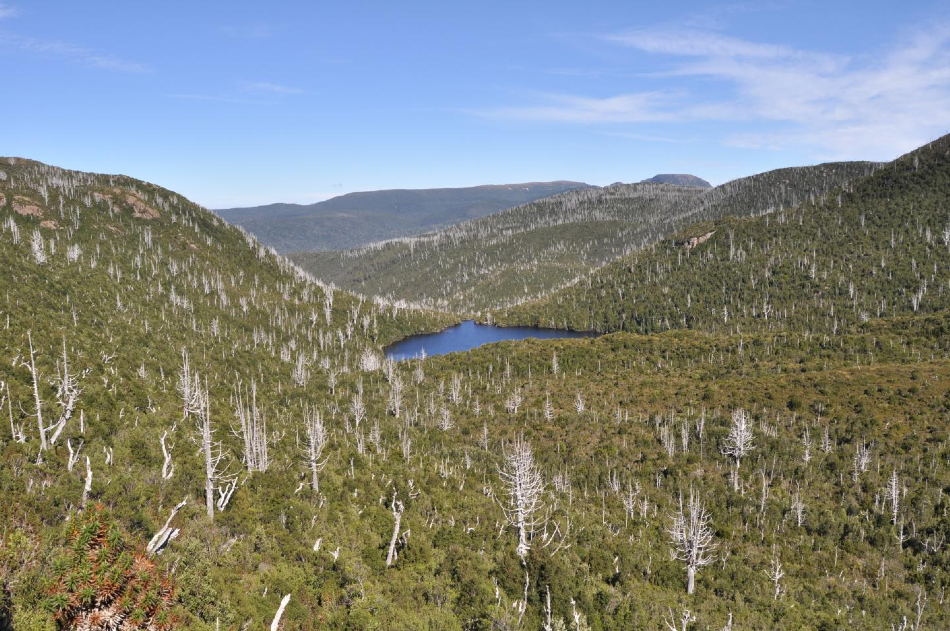Mar 4 2020
New research at Portland State University reports that the ancient rainforest region of Tasmania faces a gloomy future due to the warming climate and the way people utilize the land. These scenarios have led to considerable changes in the island state off mainland Australia’s southeastern coast.
 Dead Billy King pines in Tasmania’s ancient temperate rainforest. Image Credit: Cameron Naficy.
Dead Billy King pines in Tasmania’s ancient temperate rainforest. Image Credit: Cameron Naficy.
The study is relevant not just for Australia, where wildfires have been more prevalent in recent months, but also for other regions of the world that are witnessing higher risks of wildfires and drying conditions.
The study’s lead author and associate professor of geography Andres Holz, from Portland State University’s College of Liberal Arts and Sciences, analyzed the decrease in the population of King Billy pine trees (Athrotaxis selaginoides), a coniferous species native to Tasmania, dating back to the era when Australia was once a part of a supercontinent known as Gondwana.
Vast areas of the UNESCO World Heritage Area in Tasmania is occupied by this paleoendemic tree species, which is regarded as a vulnerable species by the World Conservation Union.
As part of the research, it was identified that more frequent fires due to regional dry and warming trends and increased ignitions by humans at the time of the early arrival of Europeans to Tasmania and of late due to increases in lightning are violating fire refugia. Refugia are regions that are protected and do not burn or, in case if they do, they are areas where trees survive a majority of the wildfires.
The areas that have survived are in these very protected refugia. The refugia can be a bit of a buffer, but how long is that going to last? We might be witnesses of a whole lineage of a very ancient plant species that is going to go extinct.
Andres Holz, Study Lead Author and Associate Professor of Geography, College of Liberal Arts and Sciences, Portland State University
According to Holz, the changes in the functions of the wildfires, caused by both climate change and management, are driving similar transformations in the ecosystem not just in Australia but also in the regions of South America’s Patagonia and western North America.
Decoding the complicated relationships between climate variability, landscape, fire disturbance, human fire usage, and anthropogenic climate change is vital to perceive the quick decline in the population of King Billy pines.
The research identified that the trees regenerated periodically before 1800 AD due to indigenous land management. However, the decline in population was caused by European colonization as they cleared the land for mining and logging purposes. This situation matched with a period of more fire-prone weather and climate conditions.
Fires co-occur with dry, warm periods and those periods are more and more frequent now. We’re moving away, climatically speaking, from the drivers that help the species.
Andres Holz, Study Lead Author and Associate Professor of Geography, College of Liberal Arts and Sciences, Portland State University
Holz added further that the Billy King pines species require cool and wet conditions to grow.
In addition, Holz, together with his team of researchers, identified very few saplings or seedlings in the study region, pointing to the fact that recovery of the original forest is doubtful. Rather, the replacement forest has turned into a tall-shrubland eco-system with less diversity of species that, on the other hand, is more flammable and recovers more rapidly after a fire.
The next time there are the same climate conditions and there’s a spark, a lightning strike or an accidental fire, the plants themselves are now more dense in space and more flammable than before and have a higher change of burning again. It becomes a vicious cycle that is hard to break.
Andres Holz, Study Lead Author and Associate Professor of Geography, College of Liberal Arts and Sciences, Portland State University
According to the study, with the increase in strength of the crucial climate-fire connections, the survival of King Billy pines might need highly focused fire management, such as a quick attack of uncontrollable fires.
The study outcomes were recently reported in the Global Change Biology journal. The co-authors of the study included Sam Wood, David Bowman, student Carly Ward from the University of Tasmania, and Thomas T. Veblen from the University of Colorado, Boulder.